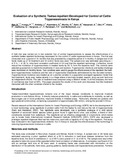| dc.contributor.author | Bett, B | |
| dc.contributor.author | Irungu, P | |
| dc.contributor.author | Andoke, J | |
| dc.contributor.author | Nyamwaro, S | |
| dc.contributor.author | Murilla, G | |
| dc.contributor.author | Saini, R | |
| dc.contributor.author | Hassanali, A | |
| dc.contributor.author | Olet, P | |
| dc.contributor.author | Kitala, P | |
| dc.contributor.author | Gathuma, G | |
| dc.contributor.author | Hargrove, J T | |
| dc.contributor.author | Randolph, TF | |
| dc.contributor.author | McDermott, JJ | |
| dc.date.accessioned | 2013-06-24T13:20:45Z | |
| dc.date.available | 2013-06-24T13:20:45Z | |
| dc.date.issued | 2006 | |
| dc.identifier.citation | Proceedings of the 11th International Symposium on Veterinary Epidemiology and Economics, 2006 | en |
| dc.identifier.uri | http://hdl.handle.net/11295/39073 | |
| dc.description.abstract | A field trial was carried out in two endemic foci of animal trypanosomosis to assess the effectiveness of a
synthetic tsetse-repellent technology developed for the control of cattle trypanosomosis in Kenya. The trial was
conducted over a period of 12 months that was preceded by a baseline period of 4 months. A sample size of 24
herds made up of 12 treatment and 12 control herds was used. The sample size was estimated assuming an •
of 5 %, • of 20 %, intra-herd correlation coefficient of 0.4 and that the repellent technology, if effective, would
reduce the incidence of trypanosomosis in treated herds by 50 % from the baseline level. The controls were
selected purposefully to match the treatments in size and location. Trypanosome infections and tsetse challenge
were monitored on monthly basis. Two variables were used to gauge the effectiveness of the repellent: the herdlevel
trypanosomosis incidence and the rate of trypanocidal treatments administered by the recruited farmers.
Trypanosomosis incidence was treated as an outcome variable in a population-averaged regression model that
had treatment, study area, tsetse density in a village where a herd was located, season, drug use and herd size
as independent effects. The rate of treatment was analyzed using a Weibull model. In all the analyses, the level
of confidence was fixed at 95%. This paper presents the results of this work and discusses how the treatment
interacted with the other variables offered to the models. | en |
| dc.language.iso | en | en |
| dc.publisher | University of Nairobi | en |
| dc.title | Evaluation of a Synthetic Tsetse-repellent Developed for Control of Cattle Trypanosomosis in Kenya | en |
| dc.type | Presentation | en |
| local.publisher | International Livestock Research Institute, Nairobi, Kenya | en |
| local.publisher | Trypanosomiasis Research Centre, Kenya agricultural Research Institute, Nairobi, Kenya | en |
| local.publisher | International Center for Insect Physiology and Ecology, Nairobi, Kenya | en |
| local.publisher | Department of Public Health Pharmacology and Toxicology, University of Nairobi , Nairobi, Kenya | en |
| local.publisher | John Hopkins University, Harare, Zimbabwe | en |
| local.publisher | Department of Veterinary Services, Nairobi, Kenya | en |

